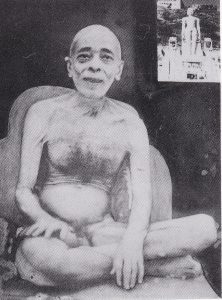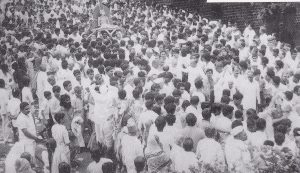Bahubali-A Saint’s Heritage
As a holder of an academic degree of education from the university of Bombay, the late Acharya Muni Samantabhadra committed his life to educating the young The spreading of knowledge, we have seen, is a duty for the Jaina; it belongs to dana the giving of gifts.
Acharya Samantabhadra, who lived half his life under British rule, wanted to see the colonial school system supplemented by imparting traditional Jaina values to the younger generations. This self-set aim imbued him with the idea of starting a school on the guidelines which used to be practised in the pre-colonial gurukulas (residential schools guided by a spiritual teacher).
It was in 1934 that he started his experiment with just five pupils in a somewhat dilapidated temple on Kumbojagiri, a holy hill about twenty kilometres cast of Kohlapur in Maharashtra. A year before, Samantabhadra had joined the Digambara ascetic order as a kshullaka (junior monk who wears three pieces of clothing).
The number of families wanting to send their children to this school increased from year to year. As the ground available on top of the hill allowed no further extension, Muni Samantabhadra decided to build a school at the foot of the hill.
Assisted by the State Government and helped by generous donations from Jaina lay people, a huge educational complex arose on the chosen site now consisting of several two-storey buildings of classrooms, houses for teachers, quarters for the guru- Jaula inmates, a large kitchen, administration offices, a printing shop, a gymnasium. toilets, and the like. Among the recent additions is a guest-house with a library and a bookstall.
Care was taken to retain the serene character of the surrounding environment. Only in the mornings and afternoons is there a busy coming and going of buses which bring the approximately one thousand boys and girls from the outlying villages to school and take them home again after classes.
The gurukula proper counts about three hundred inmates, only they all boys- receive religious instruction and must come from Jaina families They wear simple white clothes and are known as brahmacharis.
The girls and boys from the villages may be of any religion or caste. The curriculum of the school must comply with governmental guidelines, and the teachers are paid by the state.
On the slope of the hill above the school a uniquely designed temple has been built, crowned by a Bahubali statue of light Rajasthani marble. This colossus, erected in 1963 and measuring eight and a half metres in height, marks the revival of the Jaina monumental art of statue sculpturing which until then had lain dormant for some centuries.
 Since then, dozens of huge Jina and Bahubali images have been installed at sacred Jaina centres throughout India; a welcome source of income for (continued page 226).
Since then, dozens of huge Jina and Bahubali images have been installed at sacred Jaina centres throughout India; a welcome source of income for (continued page 226).
General view of the Bahubali Temple, Gurukula and Educational Compas 321. A closer view of the rear terraces of the temple and the Bahubali statue. On the left of the upper terrace a three-dimensional replica of the sacred mountain Sammeta Shikhara in Bihar sculptors at places like Karkala in Karnataka and Jaipur in Rajasthan (these stone- masons, it should be noted, belong to a special Hindu-caste and are no Jainas).
It was within the precincts of this temple that Acharya Muni Samantabhadra put his mortal body to rest by observing the rite of sallekhana by slowly reducing the intake of nourishment. He died fully awake on the 18th of August 1988 In December of the same year he would have been ninety-seven years of age. From 1952, when he became a fully ordained Digambara monk, he never wore a piece of clothing, never sat down to a meal, never used a vehicle.
 The heritage he left behind is there to be marvelled at by everybody whose path takes him to this model of a gurukula at the foot of this sacred hill better known nowadays by the name of Bahubali. For Shvetambara pilgrims to this site the place of worship is a renovated old temple sacred to Parshvanatha on top of the hill. There is a dharmashala annexed to this temple.
The heritage he left behind is there to be marvelled at by everybody whose path takes him to this model of a gurukula at the foot of this sacred hill better known nowadays by the name of Bahubali. For Shvetambara pilgrims to this site the place of worship is a renovated old temple sacred to Parshvanatha on top of the hill. There is a dharmashala annexed to this temple.
322. The late Acharya Muni Samantabhadra in his cell with window opening to the 8.5 m high Bahu bali statue.
323. August 1988, thousands of devotees pay their last homage to the saint whose dead body, seated in meditation posture, is carried to the cremation ground. (Both photos courtesy Sammati Publication. Bahubali Kolhapur.)
